We’re not quite sure if we’re supposed to have this PDF but it’s just landed in our lap and we don’t see any confidential markings so we might as well relay the info. It’s a slide set from an investor meeting from the Ultra Mobility group and it highlights a few interesting points about Moorestown and Medfield. It appears to be dated 05_2009 so it’s very recent.
The first slide shows where Medfield fits in. Its built on a 32nm process and there’s a clear move towards smartphones and you can see that, along with the important 400 million market figure! (TAM=Total Addressable Market.) in the slide below. Timeframe is 2011.
These two slides (click to enlarge) show Moorestown in a bit more detail. Clearly theres a focus on standby power which is important for leaving a device on all day. From previous info we know that Moorestown should include hardware video encoding and well as decoding. YouTube 720P MID anyone?
Here you can see board sizes. Moorestown and Medfield will allow smaller screens but more importantly, more space for design which means keyboards, sensors, larger batteries. A lot of design flexibility.
This slide, one of three similar slides, is showing how Moorestown stacks up against what’s needed for smartphone use. ‘Scenario power’ is not explained but I assume it’s a typical usage scenario for an internet connected smartphone. 300mW is about what most people are using on their smartphones today but far less (more than 10x less) than what you’ll be using on one of the latest Menlow-based MIDs and 30x less than a netbook. The slide following this (not show here) shows a full ticklist for Medfield.
I won’t link the PDF here but I will ask for permission to copy it and host it here.
The full PDF is available here.
I said yesterday that I’m trying not to get excited about Medfield but when slides like these crop up, I can’t stop myself!

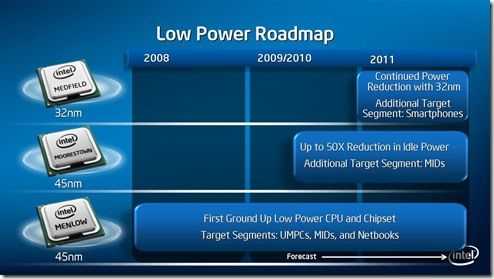
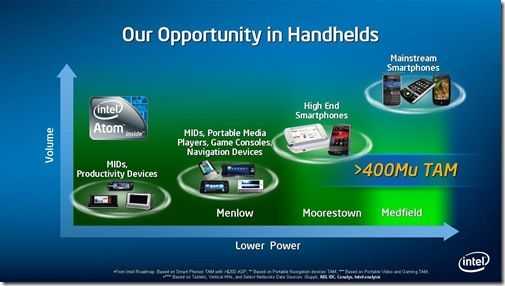
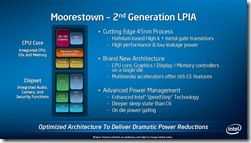
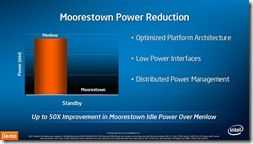
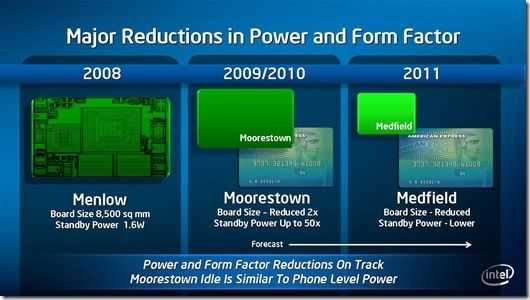
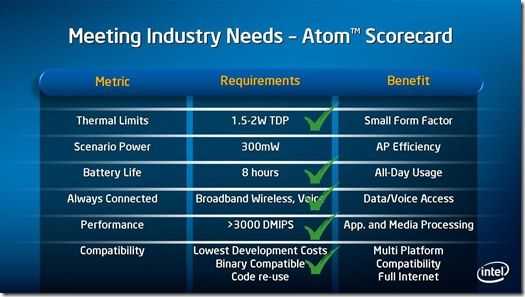










New article: Intel Investor Presentation Highlights Smartphone Push. http://cli.gs/N5386R
Intel Investor Presentation Highlights Smartphone Push. http://ff.im/-2V9JJ
By 2011 the ARM based processors will have probably have moved the goalposts.
Another thing, it’s one thing having a CPU available by 2011, it’s another thing totally to get a phone released using it in a similar time frame. It would be more like 2012 before any smartphone product were available (especially in the USA).
For a smartphone, it’s the rest of the SOC which provides the usability. Without an efficient GPU and video encoder/decoder the X86 CPU is going to be doing a lot of heavy lifting. Once you’re in the smartphone area I don’t know how much the ability to run X86 code is driving the design decisions.
It’s more interesting for MIDs and UMPCs
missing the point a bit, by that time intel will be offering two for the price of one, a mobile pc and phone in a single device well arm are still only able to offer a mobile phone, it wont be one laptop per child, it will be one Intel based MID per child, these devices will completely undermine the traditional old mobile phone oem’s
Scoop!
I’m inspired by Menlow. Moorestown is a far future. First MID’s on Moorestown will be in late 2010 (1,5 year to wait)
Can Menlow-based MID weight 250gm?
I agree with you, Chippy, that now software is bigger issue (even than power consumption of Menlow platform)
As it stands right now, Intel’s platform has much more to improve than ARMs simply because of the lack of integration on current generation devices. Sure, ARM will progress, but they are showing off the best. It’ll be a little while before Intel goes full SoC and it’ll be more comparable.
Intel Investor Presentation Highlights Smartphone Push; Delivered By 2011 http://bit.ly/7JJVN #intel #cellphones #mobile
Intel is targetting mainstream smartphons with MedField. Timeframe is 2011. http://bit.ly/Mtosv